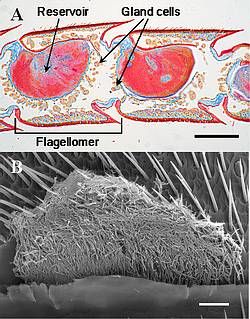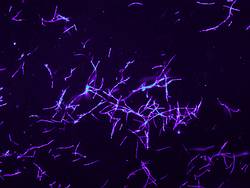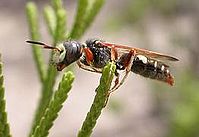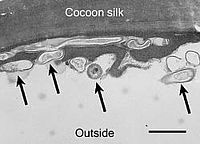
Beewolf Symbionts
Symbionts for pathogen defense – Beewolves and their antennal bacteria
Symbiotic associations between different organisms are of great importance for evolutionary and ecological processes. Bacteria are particularly valuable symbiotic partners due to their huge diversity of biochemical pathways that may open entirely new ecological niches for higher organisms. Recently, we discovered a unique association between a new Streptomyces species and the European Beewolf (Philanthus triangulum, Hymenoptera, Crabronidae). Beewolf females cultivate the Streptomyces bacteria in specialized antennal glands and apply them to the brood cell prior to oviposition. The bacteria are taken up by the larva and occur on the walls of the cocoon. Bioassays indicate that the streptomycetes protect the cocoon from fungal infestation and significantly enhance the survival probability of the larva, possibly by producing antibiotics. Behavioral observations strongly suggest a vertical transmission of the bacteria.
We screened 23 congeneric beewolf species for symbiotic bacteria in the antennae and found the Streptomycetes to be present in all Philanthus species. However, closely related genera of the subfamily Philanthinae (Aphilanthops, Clypeadon, Cerceris) did not seem to harbor symbiotic bacteria in the antennae. Thus, the symbiosis with Streptomyces bacteria probably evolved around the origin of the genus Philanthus. This mutualistic association is the first case of bacteria being cultivated in insect antennae and the first example of a symbiosis involving bacteria of the important antibiotic-producing genus Streptomyces.
We are currently investigating the phylogenetic relationships among hosts and symbionts to test for coevolution and cospeciation. Strictly congruent phylogenies would indicate a long history of vertical transmission of the bacteria and cospeciation with the hosts, whereas lack of congruence would point to horizontal transmission events of bacteria between different host species and/or acquisition of bacteria from the environment.


Fotos © Martin Kaltenpoth
 |  |
Fotos © Martin Kaltenpoth
Publications
Kaltenpoth M, Yildirim E, Gürbüz M, Herzner G, Strohm E (accepted) Refining the roots of the beewolf-Streptomyces symbiosis: Antennal symbionts in the rare genus Philanthinus (Hymenoptera, Crabronidae). Applied and Environmental Microbiology
Goettler, W., Kaltenpoth, M., Herzner, G., Strohm, E. (2007) Morphology and ultrastructure of a bacteria cultivation organ: The antennal glands of female European beewolves, Philanthus triangulum (Hymenoptera, Crabronidae). Arthropod Structure and Development 36: 1-9.
Kaltenpoth, M. (2006) Symbiotische Streptomyces-Bakterien in Grabwespen. Naturwissenschaftliche Rundschau 59 (11): 618-619.
Kaltenpoth, M., Göttler, W., Dale, C., Stubblefield, J.W., Herzner, G., Roeser-Mueller, K., and Strohm, E. (2006) 'Candidatus Streptomyces philanthi', an endosymbiotic streptomycete in the antennae of Philanthus digger wasps. International Journal of Systematic and Evolutionary Microbiology 56 (6): 1403-1411.
Kaltenpoth, M. (2005). Bakterien schützen Wespen-Nachwuchs vor Pilzbefall. Naturwissenschaftliche Rundschau 58: 329-330.
Kaltenpoth, M., Göttler, W., Herzner, G. and Strohm, E. (2005). Symbiotic bacteria protect wasp larvae from fungal infestation. Current Biology 15: 475-479.
